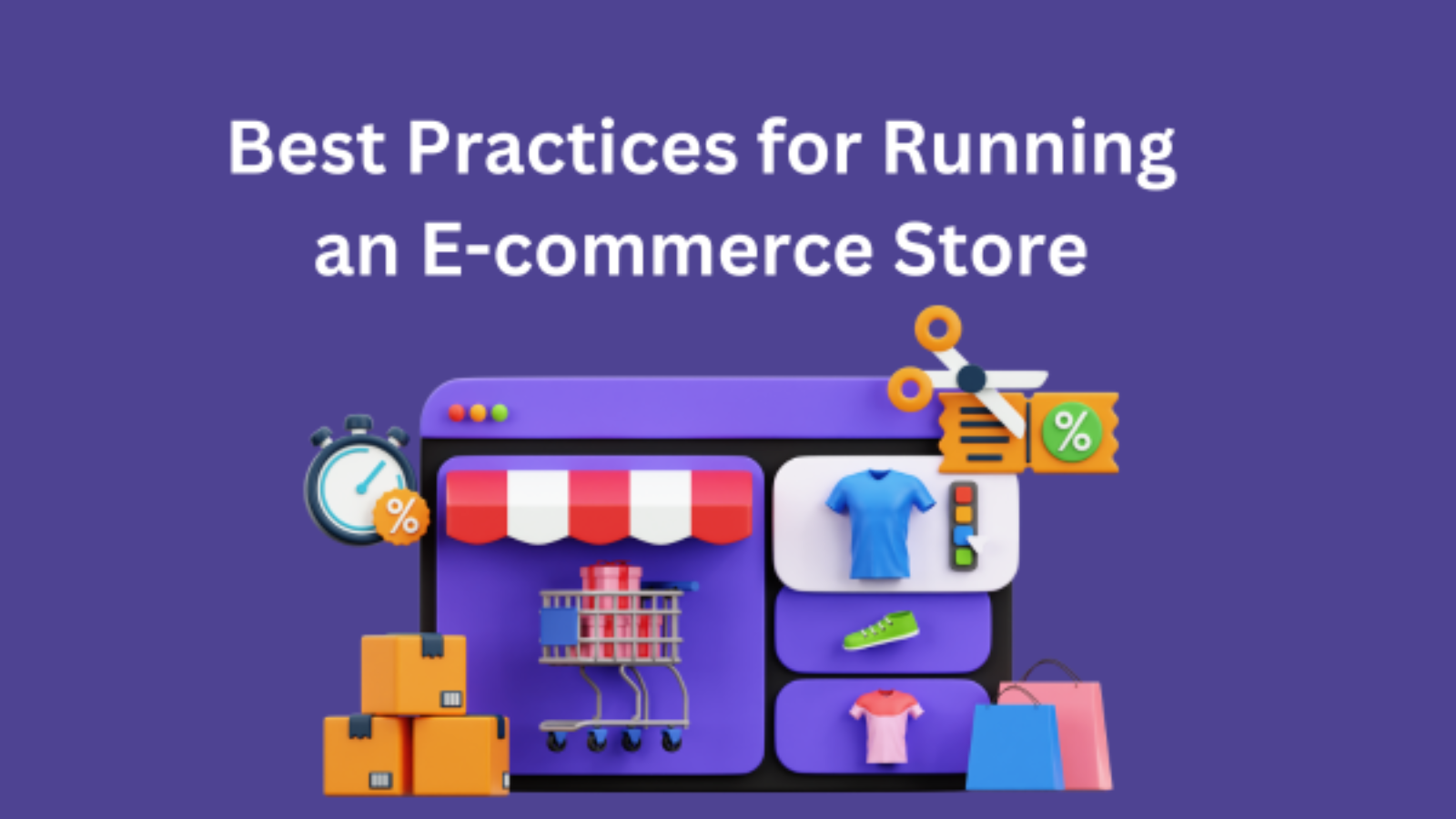Introduction
In the rapidly evolving world of online shopping, running an e-commerce store has become both an opportunity and a challenge. The convenience of online shopping has attracted millions of consumers, making it a lucrative field for entrepreneurs. However, with this opportunity comes fierce competition, and only those who adopt the best practices can thrive. This blog will explore the most effective strategies for managing an e-commerce store, backed by real-world case studies to illustrate their impact.
Table of Contents
1. User-Friendly Website Design
A user-friendly website is the cornerstone of any successful e-commerce store. It ensures that visitors can easily navigate through the site, find what they’re looking for, and make purchases with minimal effort.
Intuitive Navigation
Intuitive navigation helps customers find products quickly and easily. Categorize products logically, use clear labels, and include a search bar.
Case Study: Zappos
Zappos, a leading online shoe retailer, excels in website navigation. Their site features a prominent search bar and well-organized categories, making it easy for customers to find products. As a result, Zappos has seen increased user satisfaction and higher conversion rates.
Mobile Responsiveness
With the growing number of mobile shoppers, having a mobile-responsive website is essential. Make sure your site is visually appealing and operates smoothly on all devices.
Case Study: ASOS
ASOS, a global fashion retailer, has a mobile-first design strategy. Their mobile site and app offer seamless navigation, fast loading times, and easy checkout processes. This focus on mobile responsiveness has helped ASOS capture a significant share of mobile shoppers, contributing to their growth.
Fast Loading Times
A sluggish website can irritate users and cause them to leave. Optimize images, use a content delivery network (CDN), and minimize code to improve loading times.
Case Study: Amazon
Amazon prioritizes speed. By using CDNs and optimizing their website architecture, they ensure fast loading times. This focus on speed is one of the reasons why Amazon remains a top choice for online shoppers.
Clear Call-to-Actions (CTAs)
CTAs guide users towards the desired action, such as making a purchase or signing up for a newsletter. Use clear, compelling language and place CTAs prominently.
Case Study: Shopify
Shopify’s website features clear CTAs like “Start Free Trial” and “Learn More” on their homepage. These CTAs are designed to capture visitors’ attention and guide them towards becoming customers.

2. Robust Product Management
Effective product management ensures that your inventory is well-organized, accurately described, and visually appealing to customers.
Detailed Product Descriptions
Provide detailed and accurate product descriptions to help customers make informed decisions. Include key features, specifications, and benefits.
Case Study: Wayfair
Wayfair, an online furniture retailer, excels in product descriptions. Each product page includes detailed information, including dimensions, materials, and customer reviews. This thorough approach helps customers make confident purchasing decisions.
High-Quality Images
High-quality images allow customers to see products clearly. Use multiple angles, zoom features, and videos to showcase products.
Case Study: IKEA
IKEA uses high-quality images and videos to showcase their products. Their website features multiple images for each product, providing a comprehensive view. This attention to visual detail enhances the shopping experience and reduces returns.
Effective Inventory Management
Keep your inventory updated to avoid stockouts and overstock situations. Utilize inventory management software to monitor stock levels and predict future demand.
Case Study: Walmart
Walmart uses advanced inventory management systems to ensure their online store is well-stocked. By integrating their online and offline inventory, they provide accurate stock information to customers, improving trust and satisfaction.
3. Customer Experience and Support
Providing excellent customer service and support can differentiate your store from competitors and build customer loyalty.
Live Chat Support
Live chat support offers real-time assistance to customers, helping them resolve issues quickly.

Case Study: Sephora
Sephora offers live chat support on their website, allowing customers to get instant answers to their questions. This feature enhances the customer experience and has contributed to Sephora’s high customer satisfaction rates.
Easy Return Policies
A hassle-free return policy can build customer trust and encourage purchases. Make the process simple and clear.
Case Study: Nordstrom
Nordstrom’s return policy is one of the most customer-friendly in the industry. They accept returns with no time limit and offer free return shipping. This policy has helped Nordstrom build a loyal customer base.
Personalized Customer Experiences
Use data to personalize the shopping experience, such as recommending products based on browsing history or previous purchases.
Case Study: Netflix
Although not an e-commerce store, Netflix’s personalization strategy is worth mentioning. By using data to recommend content, they keep users engaged and satisfied. E-commerce stores can adopt similar strategies to recommend products and enhance the shopping experience.
4. Effective Marketing Strategies
Marketing is crucial for attracting and retaining customers. Utilize a mix of strategies to reach your target audience effectively.
SEO (Search Engine Optimization)
Enhance your website’s search engine optimization to boost visibility and draw in organic traffic. Focus on relevant keywords, quality content, and technical SEO.
Case Study: Etsy
Etsy invests heavily in SEO to attract customers looking for unique handmade and vintage items. By optimizing their product listings and website structure, they rank highly in search results, driving significant organic traffic.
Content Marketing
Create valuable content that resonates with your audience. Use blogs, videos, and social media to engage customers and build brand authority.
Case Study: REI
REI, an outdoor gear retailer, uses content marketing effectively. Their blog features articles on outdoor activities, gear guides, and adventure stories. This content not only attracts visitors but also establishes REI as an authority in the outdoor industry.
Email Marketing
Email marketing serves as a highly effective tool for building and maintaining strong customer relationships. Send personalized emails, product recommendations, and promotional offers.
Case Study: Birchbox
Birchbox, a beauty subscription service, excels in email marketing. They send personalized emails with product recommendations, beauty tips, and exclusive offers with multiple payment options to cater to the diverse preferences of your customers.
Social Media Engagement
Engage with your audience on social media platforms. Share content, run promotions, and interact with customers to build a community around your brand.

Case Study: Glossier
Glossier leverages social media to engage with their audience. They use platforms like Instagram to share user-generated content, run promotions, and interact with customers. This social media strategy has helped Glossier build a strong and loyal customer base.
5. Secure Payment and Data Protection
Ensuring secure payment methods and protecting customer data is essential for building trust and avoiding legal issues.
Secure Payment Gateways
Use reliable and secure payment gateways to process transactions. Offer multiple payment options to cater to different customer preferences.
Case Study: Stripe
Stripe is a popular payment gateway used by many e-commerce stores. It provides robust security features and supports multiple payment methods, making it a trusted choice for online transactions.
SSL Certificates
An SSL certificate encrypts data transmitted between your website and customers, protecting sensitive information.
Case Study: Shopify
Shopify includes SSL certificates for all their online stores, ensuring that customer data is encrypted and secure. This focus on security builds trust and protects customer information.
PCI Compliance
Ensure your store complies with the Payment Card Industry Data Security Standard (PCI DSS) to protect cardholder data.
Case Study: PayPal
PayPal, a leading payment processor, is PCI compliant and implements stringent security measures to protect customer data. This compliance ensures that e-commerce stores using PayPal can safely process payments.
6. Analyzing and Improving Performance
Regularly analyzing your store’s performance and making data-driven improvements is crucial for sustained success.
Use of Analytics Tools
Utilize analytics tools to track key metrics such as traffic, conversion rates, and customer behavior. Use this data to make informed decisions.
Case Study: Google Analytics
Many e-commerce stores use Google Analytics to track their performance. It provides detailed insights into user behavior, helping store owners identify areas for improvement and optimize their strategies.
Key Performance Indicators (KPIs)
Identify and monitor KPIs that are relevant to your business, such as average order value, customer acquisition cost, and customer lifetime value.
Case Study: Blue Apron
Blue Apron tracks KPIs like customer acquisition cost and customer lifetime value to optimize their marketing strategies and improve profitability. By focusing on these metrics, they can make data-driven decisions that enhance their business performance.
Data-Driven Decision Making
Use the data collected to make informed decisions and implement changes that drive growth and efficiency.
Case Study: Netflix
Netflix’s data-driven approach to content recommendations has been highly successful. By analyzing user data, they continuously improve their recommendation algorithms, leading to increased user satisfaction and retention.
Conclusion
Running a successful e-commerce store requires a combination of user-friendly design, robust product management, excellent customer support, effective marketing, secure payment methods, and data-driven decision making. By adopting these best practices, you can enhance the customer experience, drive sales, and build a thriving online business.
Ready to take your e-commerce store to the next level? Get a free Consultation

